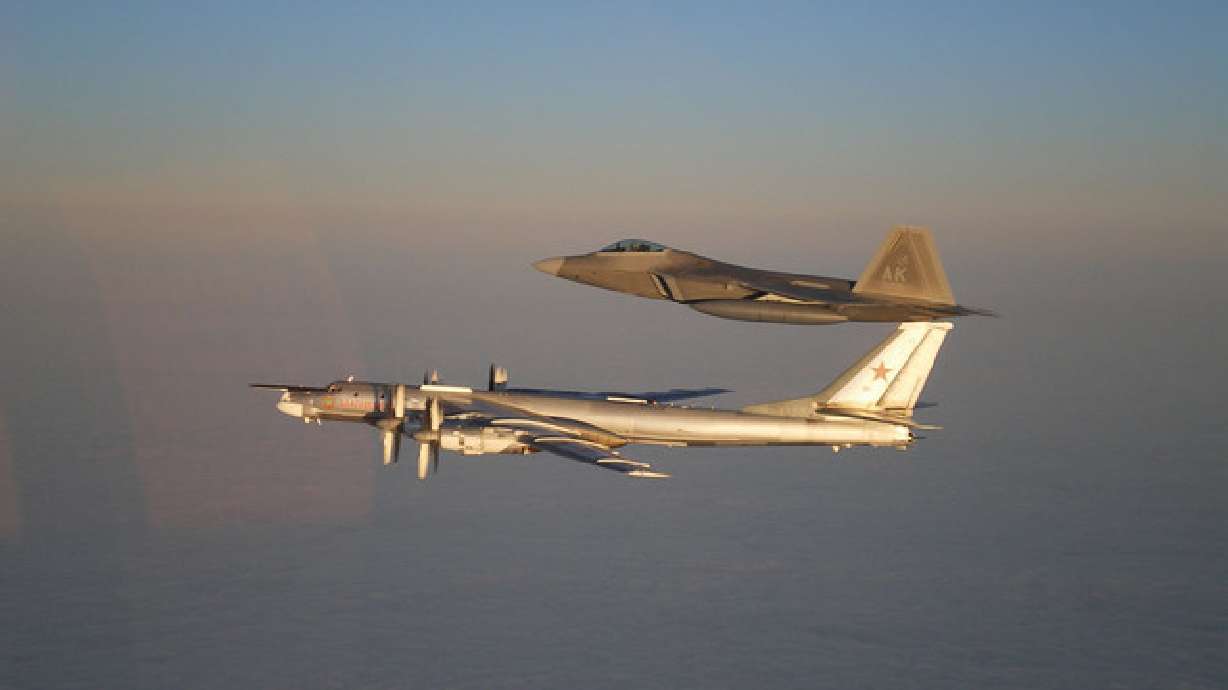Estimated read time: 4-5 minutes
This archived news story is available only for your personal, non-commercial use. Information in the story may be outdated or superseded by additional information. Reading or replaying the story in its archived form does not constitute a republication of the story.
(CNN) — U.S. fighter jets intercepted Russian bombers off Alaska and California this month, the latest incidents in a string of recent aerial encounters over the Pacific.
On June 4, according to U.S. defense officials, four long- range Russian Tu-95 Bear-H bombers, accompanied by an aerial refueling tanker, flew into the U.S. Air Defense Identification Zone, an area extending 200 miles from the North American coast, off Alaska, where they were intercepted by U.S. F-22 fighter jets.
Two of the Russian bombers peeled off and headed west, while the other two flew south and were identified by U.S. F-15 fighters within 50 miles of the California coast.
Capt. Jeff Davis, a spokesman for the North American Aerospace Defense Command, said it was the first time U.S. jets had intercepted Russian military aircraft off California since July 4, 2012.
Pentagon spokesman Col. Steve Warren said it is believed the Russian planes were on a training mission.
Davis said the Russian planes were entirely within their rights during the flight.
"They followed all the protocols, and it was a very professional encounter on both sides," he said. "There was nothing that they were doing that was contrary to international law."
The Russian planes never entered U.S. territory proper, which by international law extends 13.8 miles (22.2 kilometers) from the U.S. coast.
According to the Federal Aviation Administration, any aircraft entering the Air Defense Identification Zone, which extends 200 miles from the coasts of the United States and Canada, must file a flight plan indicating their intentions, must maintain radio contact with air controllers and must have an operational radar transponder.

Davis said Russian flights into the air defense zone are intercepted about 10 times a year.
But earlier this year, a top U.S. Air Force general said Russia was stepping up its military activities in the Asia-Pacific region as tensions increased over the Ukraine and Russia's move into Crimea.
Gen. Herbert "Hawk" Carlisle, in a presentation to the Center for Strategic and International Studies in Washington, talked up the increased Russian activity.
"They've come with their long-range aviation off the coast of California; they circumnavigated Guam," Carlisle said, showing a picture of a U.S. F-15 fighter "intercepting" a Russian bomber off the Pacific island.
Guam is home to Andersen Air Force Base, which has been used by the U.S. military for flights of B-2 and B-52 bombers across the Pacific.
Flights around Japan and the Korean Peninsula have also "increased drastically," as has naval activity in that area, Carlisle said.
The confrontations aren't just near U.S. airspace. In April, a U.S. Air Force surveillance plane was buzzed by a Russian jet fighter while flying over the Sea of Okhotsk between Russia and Japan, U.S. military officials said.
Describing the fly-by as "straight out of a movie," one U.S. official said a Russian Su-27 fighter jet flew within 100 feet of the nose of a U.S. Air Force RC-135U jet. The Russian aircraft turned and "showed its belly" to the U.S. crew so they could see it was armed with missiles, a U.S official said.
Also in April, U.S. defense officials say, a Russian fighter jet made a dozen low-altitude passes over the USS Donald Cook, a U.S. Navy guided missile destroyer that was operating in the Black Sea.
On April 28, a Russian Defense Ministry statement said Russian Defense Minister Sergey Shoygu and U.S. Defense Secretary Chuck Hagel had discussed both incidents during a phone call that day.
In response, the statement said, Shoygu "offered to instruct the commanders in chief of the armed forces of both countries to discuss possible additional measures to address the interests of both countries to prevent future misperceptions of actions."
On the other side of the world, F-16 fighter jets from the Netherlands intercepted two Russian bombers in April. The Russian planes, which had come about a half-mile into Dutch airspace, were escorted out and then monitored by British planes as they flew north of Scotland.
In a high-profile training mission of its own, the U.S. Air Force this week sent two of its top-of-the-line B-2 stealth bombers to an air base in Britain to conduct training operations. Three B-52 bombers were also sent from the U.S. on a two-week deployment to England, also for training purposes, according to an Air Force news release.
CNN's Jim Scuitto, Barbara Starr, Jake Tapper, Edward Meagher, Jeremy Diamond, Joshua Berlinger, Lindsay Isaac, Greg Botelho and Mariano Castillo contributed to this report.
The-CNN-Wire™ & © 2014 Cable News Network, Inc., a Time Warner Company. All rights reserved.









